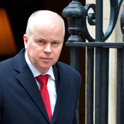Above, Aristotle identified the elements of a good speech
The party conference season is upon us: Tories at Manchester, Labour in Liverpool, and the Lib Dems gladdening Birmingham with their yellow pennants and insane optimism. What can we expect? Speeches, of course. Some of them “keynote,” even.Such speeches can make or break a leader’s career, and political trainspotters will, naturally, be all over them. However for trainspotters of another stripe—ones like me—the action is not over policy, but rhetoric. Here are some notes on what to look for.
Aristotle said there were three appeals that rhetoric could make: ethos, pathos and logos. These are, roughly: establishing the credibility of the speaker; stirring the audience’s emotions; and appealing to logic and reason. Any speech blends all three. But in political rhetoric, at a rally or a conference, the ethos appeal is uppermost, while logos and pathos are secondary. You argue for policy in parliament and in cabinet. At conference, you rally your troops and, in the media age, reach beyond them to the undecided.
So it’s about self-presentation: a shaping of speaker and immediate audience, along with a wider implied audience, into a whole. A conference speech seeks to turn, and a great conference speech succeeds in turning, “me and you” into “we.” Hence the workmanlike peroration of David Cameron’s spring conference speech: “Today let the same confidence ring out from this hall and this party… we believe in the British people and our power together to build a better future. Together we’ll create the businesses, we’ll create the jobs, we’ll create the opportunities, we’ll light the spark of enterprise, we’ll fire our economy, we’ll drive our country forward, and together we will do it.”
Note here the typical outward movement from “hall” to “party” to “people” and from “jobs” to “opportunities” to “enterprise” to “economy” to “country” and finally to “it,” whatever that may be: from the small, local and concrete to the large, national and abstract. This is where a personal narrative—yucky term, I know—is made emblematic of a national narrative: Margaret Thatcher’s grocer’s shop and housewife economics; Gordon Brown’s manse (“these are my values—the values I grew up with in an ordinary family in an ordinary town”); or Tony Blair’s questionable anecdotes about his childhood love of football.
What was the worst failure of ethos in a leader’s speech to his party in living memory? You’d have to go some way to beat Neil Kinnock’s performance at the 1992 Sheffield rally where, apparently intoxicated by favourable opinion polls and the brass band that preceded him, he took to the podium and bellowed three times: “We’re ALL RIGHT!” before announcing, beaming with self-assurance: “This is the Labour party. This is the party that’s going to win the election and win for our country.”
Here was a leader in the heartland of his tribe, addressing that tribe alone—and apparently forgetting that the other tribes not only had televisions, but votes. The right-wing Tories who spent their post-1997 wilderness years preaching to the choir know that mistake all too well. So does the David Steel of “Go back to your constituencies and prepare for government.”
As far as sentence-by-sentence composition goes, all the classical tricks still work. The tricolons or groups of three (parodically, Tony Blair’s “education, education, education”); the balanced antitheses, such as Brown’s evocation in his 2009 speech of “the Britain where we don’t just care for ourselves, we also care for each other.” But repetition will likely be uppermost. Anaphora and epistrophe, rolling repetitions at the beginnings or ends of sentences, are the bread and butter of conference speeches.
Repetition has always been central to rhetoric. The standard reference, Richard A Lanham’s A Handlist of Rhetorical Terms, groups no fewer than 36 separate figures under “repetition,” subdividing into repetition of everything from letters to ideas. If a party leader wants you to come away with a nutshell idea, he’ll take a phrase and repeat it. Consequently a lot of the analysis that gets done on party leaders’ big speeches whether at conference or in the run-up to an election, is quantitative. How many times was a given word used? Which key soundbites were being pimped for inclusion in a headline? That is the sort of analysis that has led us to identify Gordon Brown with the word “prudence.” Five years ago, we’d usually have these presented to us as frequency lists, although now computer-generated wordclouds are becoming popular.
The quantitative method reflects something in the way speeches are reported and, in turn, the way they are written. There’s an ongoing arms race between political speechwriting and media technology. The soundbite has been around for ages, but it came into its own in the age of rolling news. If a politician knows that only a 20-second clip of his interview will make it onto the TV news, and that it will be continually repeated, he has an interest in answering all questions, however obtusely, with a variation on his preferred 20-second clip.
That worked until it became possible to watch the full interview on YouTube, as Ed Miliband, shown recently parroting a line with earnest inanition, discovered to his cost. Years ago, Ronald Reagan’s speechwriter Peggy Noonan said that for soundbites to be effective, they need to be more than bolt-on advertising slogans: “they are part of the tapestry—they aren’t a little flower somebody sewed on.”
To adapt Barack Obama’s ploce that one should “disagree without being disagreeable,” then, the effective conference speaker will use repetition without being repetitious. And he will “be himself” in such a way that makes “himself” stand for all of us. Let’s see who manages it.
Read more at our blog:
Five fine speeches...and two that went a bit awry - A run down of famous and infamous speeches, from Satan to Sarah Palin, compiled by Sam Leith
The party conference season is upon us: Tories at Manchester, Labour in Liverpool, and the Lib Dems gladdening Birmingham with their yellow pennants and insane optimism. What can we expect? Speeches, of course. Some of them “keynote,” even.Such speeches can make or break a leader’s career, and political trainspotters will, naturally, be all over them. However for trainspotters of another stripe—ones like me—the action is not over policy, but rhetoric. Here are some notes on what to look for.
Aristotle said there were three appeals that rhetoric could make: ethos, pathos and logos. These are, roughly: establishing the credibility of the speaker; stirring the audience’s emotions; and appealing to logic and reason. Any speech blends all three. But in political rhetoric, at a rally or a conference, the ethos appeal is uppermost, while logos and pathos are secondary. You argue for policy in parliament and in cabinet. At conference, you rally your troops and, in the media age, reach beyond them to the undecided.
So it’s about self-presentation: a shaping of speaker and immediate audience, along with a wider implied audience, into a whole. A conference speech seeks to turn, and a great conference speech succeeds in turning, “me and you” into “we.” Hence the workmanlike peroration of David Cameron’s spring conference speech: “Today let the same confidence ring out from this hall and this party… we believe in the British people and our power together to build a better future. Together we’ll create the businesses, we’ll create the jobs, we’ll create the opportunities, we’ll light the spark of enterprise, we’ll fire our economy, we’ll drive our country forward, and together we will do it.”
Note here the typical outward movement from “hall” to “party” to “people” and from “jobs” to “opportunities” to “enterprise” to “economy” to “country” and finally to “it,” whatever that may be: from the small, local and concrete to the large, national and abstract. This is where a personal narrative—yucky term, I know—is made emblematic of a national narrative: Margaret Thatcher’s grocer’s shop and housewife economics; Gordon Brown’s manse (“these are my values—the values I grew up with in an ordinary family in an ordinary town”); or Tony Blair’s questionable anecdotes about his childhood love of football.
What was the worst failure of ethos in a leader’s speech to his party in living memory? You’d have to go some way to beat Neil Kinnock’s performance at the 1992 Sheffield rally where, apparently intoxicated by favourable opinion polls and the brass band that preceded him, he took to the podium and bellowed three times: “We’re ALL RIGHT!” before announcing, beaming with self-assurance: “This is the Labour party. This is the party that’s going to win the election and win for our country.”
Here was a leader in the heartland of his tribe, addressing that tribe alone—and apparently forgetting that the other tribes not only had televisions, but votes. The right-wing Tories who spent their post-1997 wilderness years preaching to the choir know that mistake all too well. So does the David Steel of “Go back to your constituencies and prepare for government.”
As far as sentence-by-sentence composition goes, all the classical tricks still work. The tricolons or groups of three (parodically, Tony Blair’s “education, education, education”); the balanced antitheses, such as Brown’s evocation in his 2009 speech of “the Britain where we don’t just care for ourselves, we also care for each other.” But repetition will likely be uppermost. Anaphora and epistrophe, rolling repetitions at the beginnings or ends of sentences, are the bread and butter of conference speeches.
Repetition has always been central to rhetoric. The standard reference, Richard A Lanham’s A Handlist of Rhetorical Terms, groups no fewer than 36 separate figures under “repetition,” subdividing into repetition of everything from letters to ideas. If a party leader wants you to come away with a nutshell idea, he’ll take a phrase and repeat it. Consequently a lot of the analysis that gets done on party leaders’ big speeches whether at conference or in the run-up to an election, is quantitative. How many times was a given word used? Which key soundbites were being pimped for inclusion in a headline? That is the sort of analysis that has led us to identify Gordon Brown with the word “prudence.” Five years ago, we’d usually have these presented to us as frequency lists, although now computer-generated wordclouds are becoming popular.
The quantitative method reflects something in the way speeches are reported and, in turn, the way they are written. There’s an ongoing arms race between political speechwriting and media technology. The soundbite has been around for ages, but it came into its own in the age of rolling news. If a politician knows that only a 20-second clip of his interview will make it onto the TV news, and that it will be continually repeated, he has an interest in answering all questions, however obtusely, with a variation on his preferred 20-second clip.
That worked until it became possible to watch the full interview on YouTube, as Ed Miliband, shown recently parroting a line with earnest inanition, discovered to his cost. Years ago, Ronald Reagan’s speechwriter Peggy Noonan said that for soundbites to be effective, they need to be more than bolt-on advertising slogans: “they are part of the tapestry—they aren’t a little flower somebody sewed on.”
To adapt Barack Obama’s ploce that one should “disagree without being disagreeable,” then, the effective conference speaker will use repetition without being repetitious. And he will “be himself” in such a way that makes “himself” stand for all of us. Let’s see who manages it.
Read more at our blog:
Five fine speeches...and two that went a bit awry - A run down of famous and infamous speeches, from Satan to Sarah Palin, compiled by Sam Leith













